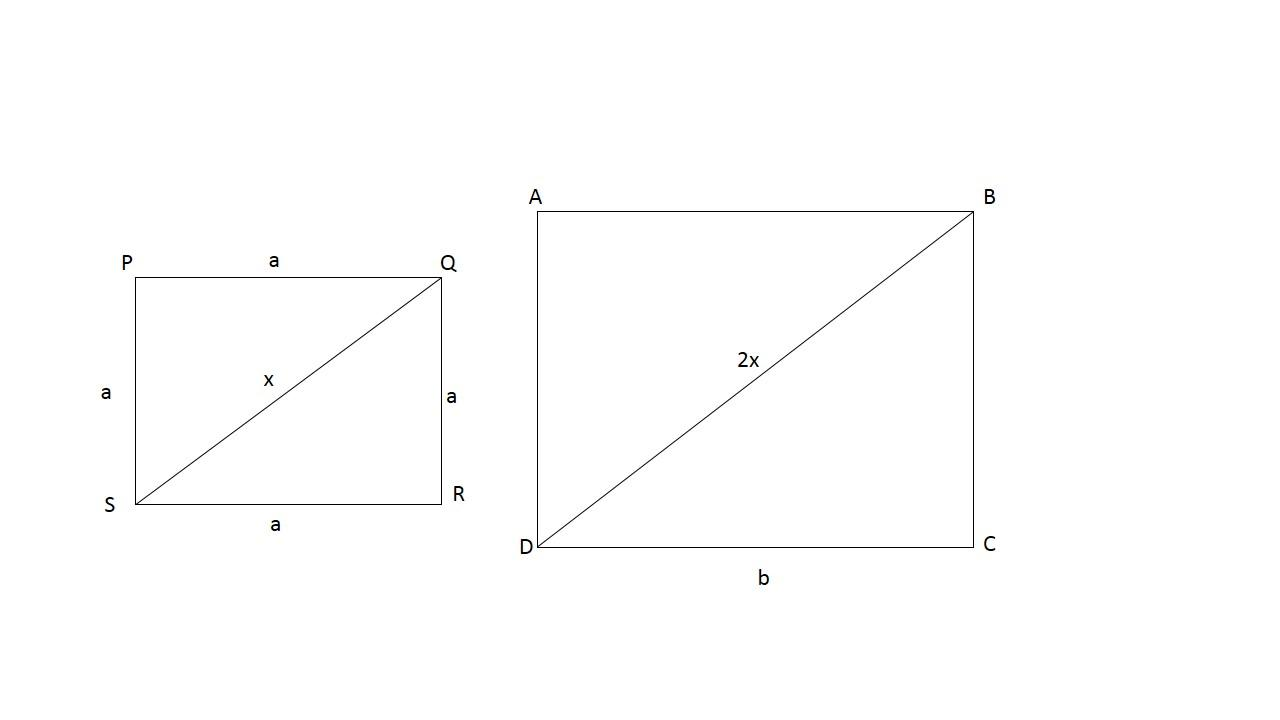
If a diagonal of a square is doubled, then the area of the square becomes m times. Find m.
Answer
482.1k+ views
Hint: Use Pythagoras theorem to find the diagonal of the square, then double it to get the new length. Use this length to compute the area of the resultant square.
Complete step by step answer:
Consider a square of side length ‘a’

Using Pythagoras theorem on $\Delta \,\text{QRS}$,
\[\begin{align}
& \text{S}{{\text{R}}^{\text{2}}}\,\text{+}\,\text{Q}{{\text{R}}^{\text{2}}}\,\text{=}\,\text{Q}{{\text{S}}^{\text{2}}} \\
& {{\text{a}}^{\text{2}}}\,\text{+}\,{{\text{a}}^{\text{2}}}\,\text{=}\,\text{Q}{{\text{S}}^{\text{2}}}
\end{align}\]
$\therefore $ length of diagonal $\text{QS}\,\text{=}\,\sqrt{\text{2}}\text{a}$
Now, according to the question, the diagonal of square
\[\begin{align}
& \text{ABCD}\,\text{=}\,\text{2 }\!\!\times\!\!\text{ }\,\text{diagonal}\,\text{of PQRS} \\
& \text{=}\,\text{2}\,\times \,\sqrt{2}a \\
& =\,2\sqrt{2}a.
\end{align}\]
Let us apply the Pythagoras theorem again on $\Delta \,\text{BCD}$
\[\text{C}{{\text{D}}^{\text{2}}}\,\text{+}\,\text{B}{{\text{C}}^{\text{2}}}\,\text{=}\,\text{BD}\]
But $\text{BD}\,\text{=}\,\text{2}\sqrt{2}\text{a}$, as derived before
\[\begin{align}
& \therefore \,\text{C}{{\text{D}}^{\text{2}}}\,\text{+}\,\text{B}{{\text{C}}^{\text{2}}}\,\text{=}\,\text{8}{{\text{a}}^{\text{2}}} \\
& \text{But}\,\text{CD}\,\text{=}\,\text{BC}\,\text{=}\,\text{b}\,\text{(New square side)} \\
& \text{2}{{\text{b}}^{2}}\,=\,8{{\text{a}}^{2}} \\
& \text{b}\,\text{=}\,\text{2a}
\end{align}\]
So the new square has a side that’s double the length of the old square.
Let’s finally compare areas
$\begin{align}
& \text{Area}\,\text{of}\,\text{PQRS}\,\text{=}\,{{\text{a}}^{\text{2}}} \\
& \text{Area}\,\text{of}\,\text{ABCD}\,\text{=}\,{{\text{b}}^{\text{2}}}\,\text{=}\,{{\text{(2a)}}^{\text{2}}}\,\text{=}\,\text{4}{{\text{a}}^{\text{2}}} \\
\end{align}$
\[\therefore \,\dfrac{\text{Area}\,\text{of}\,\text{ABCD}}{\text{Area}\,\text{of}\,\text{PQRS}}\,\text{=}\,\dfrac{\text{4}{{\text{a}}^{\text{2}}}}{{{\text{a}}^{\text{2}}}}\,\text{=}\,\text{4}\]
Hence m = 4
Note: Remember that if a square changes its length by la times, its area changes by a factor of ${{\text{l}}^{2}}$, depending on whether the length is increase or decreases.
$\begin{align}
& \text{If}\,\text{a}\,\to \,\text{la}\,\text{then}\,\text{area}\,\to \,{{\text{l}}^{\text{2}}}\,\text{area} \\
& \text{If}\,\text{a}\,\to \,\dfrac{\text{l}}{\text{l}}\text{a}\,\text{then}\,\text{area}\,\to \,\dfrac{\text{l}}{{{\text{l}}^{\text{2}}}}\,\text{area} \\
\end{align}$
Complete step by step answer:
Consider a square of side length ‘a’

Using Pythagoras theorem on $\Delta \,\text{QRS}$,
\[\begin{align}
& \text{S}{{\text{R}}^{\text{2}}}\,\text{+}\,\text{Q}{{\text{R}}^{\text{2}}}\,\text{=}\,\text{Q}{{\text{S}}^{\text{2}}} \\
& {{\text{a}}^{\text{2}}}\,\text{+}\,{{\text{a}}^{\text{2}}}\,\text{=}\,\text{Q}{{\text{S}}^{\text{2}}}
\end{align}\]
$\therefore $ length of diagonal $\text{QS}\,\text{=}\,\sqrt{\text{2}}\text{a}$
Now, according to the question, the diagonal of square
\[\begin{align}
& \text{ABCD}\,\text{=}\,\text{2 }\!\!\times\!\!\text{ }\,\text{diagonal}\,\text{of PQRS} \\
& \text{=}\,\text{2}\,\times \,\sqrt{2}a \\
& =\,2\sqrt{2}a.
\end{align}\]
Let us apply the Pythagoras theorem again on $\Delta \,\text{BCD}$
\[\text{C}{{\text{D}}^{\text{2}}}\,\text{+}\,\text{B}{{\text{C}}^{\text{2}}}\,\text{=}\,\text{BD}\]
But $\text{BD}\,\text{=}\,\text{2}\sqrt{2}\text{a}$, as derived before
\[\begin{align}
& \therefore \,\text{C}{{\text{D}}^{\text{2}}}\,\text{+}\,\text{B}{{\text{C}}^{\text{2}}}\,\text{=}\,\text{8}{{\text{a}}^{\text{2}}} \\
& \text{But}\,\text{CD}\,\text{=}\,\text{BC}\,\text{=}\,\text{b}\,\text{(New square side)} \\
& \text{2}{{\text{b}}^{2}}\,=\,8{{\text{a}}^{2}} \\
& \text{b}\,\text{=}\,\text{2a}
\end{align}\]
So the new square has a side that’s double the length of the old square.
Let’s finally compare areas
$\begin{align}
& \text{Area}\,\text{of}\,\text{PQRS}\,\text{=}\,{{\text{a}}^{\text{2}}} \\
& \text{Area}\,\text{of}\,\text{ABCD}\,\text{=}\,{{\text{b}}^{\text{2}}}\,\text{=}\,{{\text{(2a)}}^{\text{2}}}\,\text{=}\,\text{4}{{\text{a}}^{\text{2}}} \\
\end{align}$
\[\therefore \,\dfrac{\text{Area}\,\text{of}\,\text{ABCD}}{\text{Area}\,\text{of}\,\text{PQRS}}\,\text{=}\,\dfrac{\text{4}{{\text{a}}^{\text{2}}}}{{{\text{a}}^{\text{2}}}}\,\text{=}\,\text{4}\]
Hence m = 4
Note: Remember that if a square changes its length by la times, its area changes by a factor of ${{\text{l}}^{2}}$, depending on whether the length is increase or decreases.
$\begin{align}
& \text{If}\,\text{a}\,\to \,\text{la}\,\text{then}\,\text{area}\,\to \,{{\text{l}}^{\text{2}}}\,\text{area} \\
& \text{If}\,\text{a}\,\to \,\dfrac{\text{l}}{\text{l}}\text{a}\,\text{then}\,\text{area}\,\to \,\dfrac{\text{l}}{{{\text{l}}^{\text{2}}}}\,\text{area} \\
\end{align}$
Recently Updated Pages
Master Class 11 Accountancy: Engaging Questions & Answers for Success

Express the following as a fraction and simplify a class 7 maths CBSE

The length and width of a rectangle are in ratio of class 7 maths CBSE

The ratio of the income to the expenditure of a family class 7 maths CBSE

How do you write 025 million in scientific notatio class 7 maths CBSE

How do you convert 295 meters per second to kilometers class 7 maths CBSE

Trending doubts
List some examples of Rabi and Kharif crops class 8 biology CBSE

In what language is our national anthem written A Sanskrit class 8 social science CBSE

State the differences between manure and fertilize class 8 biology CBSE

Public administration is concerned with the administration class 8 social science CBSE

Who was the chairman of the drafting committee of the class 8 social science CBSE

What led to the incident of Bloody Sunday in Russia class 8 social science CBSE




